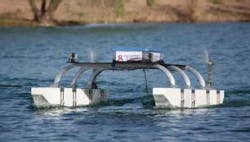Cameras on a cat sail into action
An associate professor at the University of Arizona’s (Tucson, Arizona, USA) department of electrical and computer engineering has developed an autonomous robot that could be used for defense and security applications.
Wolfgang Fink’s so-called TEX II robotic catamaran is currently fitted with onboard cameras and sonar that can penetrate up to 100 meters. But according to Fink, other sensors could be added to detect pathogens, toxins, explosives, and radioactive material.
TEX II was designed as a catamaran for enhanced stability and to allow the various onboard sensors easy access to the surface and subsurface of the water upon which it is deployed.
It weighs about 100 pounds and its central raised deck can carry a 150-pound payload of computers, batteries and sensors. The twin hulls are each 6 feet long and set about 5 feet apart.
Air-propellers mounted at the back of each hull are powered by electric motors that can switch rotational direction to drive TEX II backward or forward, which makes the craft highly agile and maneuverable -- for example, TEX II can pivot in position, which no single-engine water craft can do.
The shallow draft of the fortified Styrofoam hulls decreases perturbation in the water around TEX II, which minimizes interference with the onboard sensors. The entire chassis and sensor deck can be decoupled from the catamaran hulls and attached to an alternative propulsion system.
-- by Dave Wilson, Senior Editor, Vision Systems Design
